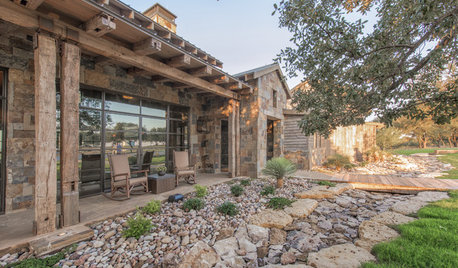Herbalism and sustainable harvesting
rusty_blackhaw
15 years ago
Related Stories

GREEN BUILDINGHow to Harvest Rainwater for Your Garden
Conserve a vital resource and save money by collecting stormwater for irrigation in a barrel or tank
Full Story
GLOBAL STYLEMy Houzz: Sustainable Bamboo for a Prototype Home in Nicaragua
Ecofriendly living has a new champion, as a Granada firm kicks off its bamboo offerings with this house's architecture and furnishings
Full Story
HOUZZ TOURSHouzz Tour: A Seattle Home Reaches for High Sustainability
Tapping into rainwater, sunlight and natural ventilation, a Washington state home gets both green cred and a gorgeous look
Full Story
GREEN BUILDINGHouzz Tour: Home Keeps Its Place on ‘Sustainability Street’
Materials are reused and recycled in a midcentury brick bungalow for an energy-efficient remodel and addition
Full Story
LANDSCAPE DESIGNProblem Solving With the Pros: Sustainable Landscape Captures Runoff
An underground cistern, permeable paving and a rain garden are part of this Washington, D.C. yard's thoughtful design
Full Story
GREEN BUILDINGMy Houzz: Sustainability Meets Global Style on an Australian Hilltop
It puts the power of the sun to work while keeping the budget in check and family socializing front and center
Full Story
LANDSCAPE DESIGNTo Manage Stormwater Sustainably, Understand Your Site
Follow this guide to learn how water moves through your landscape and how best to manage it
Full Story
FURNITUREEasy Green: Stylish Ecofriendly Furniture
Organic fabrics and sustainably harvested wood mean you can feel good about your furniture choices in more ways than one
Full Story
GREENKitchen of the Week: Green and Gorgeous in California
An apple-green countertop color matches this kitchen renovation's green approach: ecofriendly floors, sustainably harvested wood and more
Full Story
GARDENING GUIDESOrganic Matters: Thwart Insect Pests With Trap Crops
Add a few sacrificial plants to your garden to lure insects away from the harvest
Full Story





fatamorgana2121
oakleif
Related Professionals
Birmingham Landscape Architects & Landscape Designers · Norton Shores Landscape Architects & Landscape Designers · Bergenfield Landscape Contractors · Galt Landscape Contractors · Hicksville Landscape Contractors · Mashpee Landscape Contractors · Vallejo Landscape Contractors · Vancouver Landscape Contractors · Chicago Ridge Landscape Contractors · Birmingham Carpenters · Murphy Carpenters · San Mateo Carpenters · Valdosta Carpenters · Arlington Roofing & Gutters · Burlington Roofing & Guttersoakleif
brendan_of_bonsai
fatamorgana2121
oakleif
brendan_of_bonsai
herbalbetty